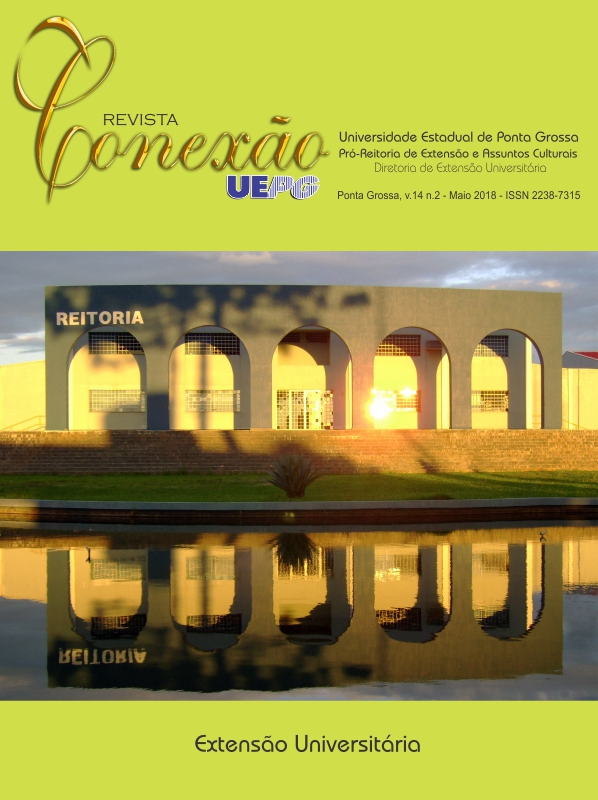INTERDISCIPLINARIDADE EM PROJETOS VOLTADOS À TERCEIRA IDADE
DOI:
https://doi.org/10.5212/Rev.Conexao.v.14.i2.0013Palavras-chave:
Interdisciplinaridade, Sociedade digital, Terceira idade.Resumo
A sociedade digital constitui-se em desafio para muitas pessoas, especialmente para a terceira idade. A realização de projetos com o objetivo de estimular pessoas desta faixa etária a construírem conhecimentos que lhes permitam inserir-se na sociedade digital é importante e merece análise. A complexidade do desafio, por sua vez, impele a uma abordagem interdisciplinar. Desse modo, o presente estudo analisa a perspectiva interdisciplinar presente na aplicação de dois projetos de extensão em que foram ministradas aulas de inserção a tecnologias para pessoas da terceira idade. Os métodos utilizados foram o exploratório e o analítico-descritivo, apoiados em análise dos resultados de forma quantitativa e qualitativa. Essa análise deu-se a partir da aplicação de questionário on-line. A principal conclusão é a de que os projetos trouxeram benefícios para todos os sujeitos envolvidos: idosos, estudantes, docentes e a própria universidade.
Downloads
Referências
ASSUMPÇÃO, Ismael. Interdisciplinaridade: uma tentativa de compreensão do fenômeno. In: FAZENDA, Ivani Catarina Arantes (Coord.). Práticas interdisciplinares na escola. 8.ed. São Paulo: Cortez, 2001.
BASTOS, Vera Regina dos Santos. Inclusão digital da terceira idade. Disponível em: <http://guaiba.ulbra.br/seminario/eventos/2009/artigos/sistemas/salao/524.pdf>.
Acesso em: 14 fev. 2016.
BRASIL. IBGE. Perfil dos idosos responsáveis pelos domicílios. Disponível em: <http://www.ibge.gov.br/home/presidencia/noticias/25072002pidoso.shtm>. Acesso em: 12 jul. 2016.
BRASIL. MINISTÉRIO DA SAÚDE. Estatuto do Idoso. 2.ed. Brasília: Ministério da Saúde, 2007.
CALDAS, Célia Pereira; VERAS, Renato Peixoto. Promovendo a saúde e a cidadania do idoso: o movimento das universidades da terceira idade. Revista Ciência & Saúde Coletiva, v. 9, n. 2, 2004. Disponível em: <http://www.scielo.br/pdf/%0D/csc/v9n2/20396.pdf>. Acesso em: 14 jul. 2016.
FAZENDA, Ivani Catarina Arantes (Org.). O que é interdisciplinaridade? São Paulo: Cortez, 2008.
______ Interdisciplinaridade: definição, projeto, pesquisa. In: FAZENDA, Ivani Catarina Arantes (Coord.). Práticas interdisciplinares na escola. 8.ed. São Paulo: Cortez, 2001.
FERREIRA, Maria Elisa de M. P. Ciência e interdisciplinaridade. In: FAZENDA, Ivani Catarina Arantes (Coord.). Práticas interdisciplinares na escola. 8.ed. São Paulo: Cortez, 2001.
FREIRE, Sueli Aparecida; SOMMERHALDER, Cinara. Envelhecer nos tempos modernos. In: FREIRE, Sueli Aparecida; NERI, Ana Liberalesso (Orgs.). E por falar em velhice. Campinas: Papirus, 2000.
GADOTTI, Moacir. Interdisciplinaridade: atitude e método. São Paulo: Instituto Paulo Freire, 2006. Disponível em: . Acesso em: 12 jul. 2016.
KANAN, Lilia Aparecida; ARRUDA, Marina Patrício de. A organização do trabalho na era digital. Revista Estudos de Psicologia, Campinas, v. 30, n. 4, out./dez. 2013. Disponível em: <http://www.scielo.br/pdf/estpsi/v30n4/11.pdf>. Acesso em: 13 jul. 2016.
LEMOS, André. Cibercultura: tecnologia e vida social na cultura contemporânea. 5.ed. Porto Alegre: Sulina, 2010.
LÉVY, Pierre._Cibercultura. São Paulo: Editora 34, 1999.
MIRANDA, Raquel Gianolla. Da interdisciplinaridade. In: FAZENDA, Ivani (Org.) O que é interdisciplinaridade? São Paulo: Cortez, 2008.
PORTAL BRASIL. Brasil é reconhecido por políticas públicas em favor de idosos. Disponível em: <http://www.brasil.gov.br/saude/2014/01/brasil-e-reconhecido-por-politicas-publicas-em-favor-de-idosos>. Acesso em: 30 abr. 2016.
THIESEN, Juares da Silva. A interdisciplinaridade como um movimento articulador no processo ensino-aprendizagem. Revista Brasileira de Educação, v.13, n. 39, set./dez. 2008.
WORLD HEALTH ORGANIZATION. Envelhecimento ativo: uma política de saúde. Brasília: Organização Pan-Americana da Saúde, 2005.
XAVIER, V.F.; DINIZ, W.Y. Qualidade de vida na terceira idade: estudo exploratório na população de duas instituições geriátricas do norte do Paraná. Disponível em: <http://fio.edu.br/cic/anais/2009_viii_cic/Artigos/07/07.11.pdf> Acesso em: 09 jul. 2016.
Downloads
Publicado
Edição
Seção
Licença
a) Os autores mantêm os direitos autorais e concedem à revista o direito de primeira publicação, com o trabalho simultaneamente licenciado sob a Creative Commons Attribution License que permite o compartilhamento do trabalho com reconhecimento da sua autoria e publicação inicial nesta revista.
b) Ao submeter um artigo à Revista Conexão UEPG e tê-lo aprovado os autores concordam em ceder, sem remuneração, os seguintes direitos à Revista: os direitos de primeira publicação e a permissão para que a Revista redistribua esse artigo e seus metadados aos serviços de indexação e referência que seus editores julguem apropriados.
c) Os leitores são livres para transferir, imprimir e utilizar os artigos publicados na Revista, desde que haja sempre menção explícita ao(s) autor (es) e à Revista Conexão UEPG e que não haja qualquer alteração no trabalho original. Qualquer outro uso dos textos precisa ser aprovado pelo(s) autor (es) e pela Revista.

Este obra está licenciado com uma Licença Creative Commons Atribuição 4.0 Internacional.





